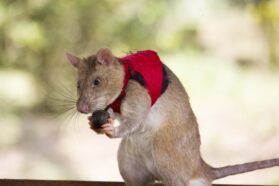arthropod: Any of numerous invertebrate animals of the phylum Arthropoda, including the insects, crustaceans, arachnids and myriapods. Adults feature an exoskeleton made of a hard material called chitin and a segmented body to which jointed appendages are attached in pairs.
average: (in science) A term for the arithmetic mean, which is the sum of a group of numbers that is then divided by the size of the group.
biology: The study of living things. The scientists who study them are known as biologists.
biomechanist: Someone who studies how living things move, especially the forces exerted by muscles and gravity on the skeletal structure.
footage: (in movies and videos) A term for the uncut or unprocessed motion pictures or video imagery taken by a camera. It takes its name from the fact that it took several feet of film to capture a few seconds of motion-picture photography.
literally: An adjective indicating that the phrase it modifies is precisely true. For instance, to say: "It's so cold that I'm literally dying," means that this person actually expects to soon be dead, the result of getting too cold.
predator: (adjective: predatory) A creature that preys on other animals for most or all of its food.
rainforest: Dense forest rich in biodiversity found in tropical areas with consistent heavy rainfall.
springtails: An order (Collembola) of more than 8,000 tiny six-legged wingless animals that live in soils around the world. They’re known for their high-jumping lifestyle, flinging themselves in the air through use of a forked and springy tail-like feature known as a furcula. Once considered insects, these hexapods no longer are for a host of reasons, including how their mouthparts attach to their bodies.









